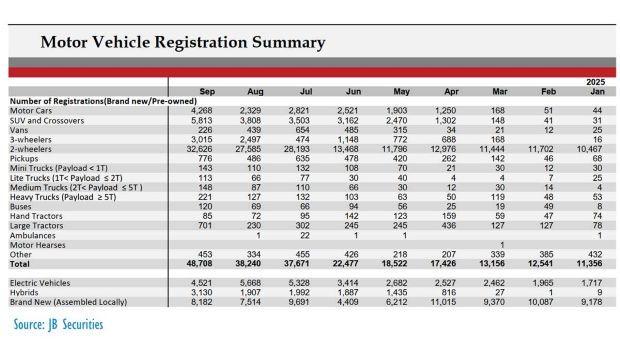COLOMBO – Sri Lanka’s vehicle registrations continued to expand in September 2025, rising 27% to 48,708 from a month earlier, with a broad increase across categories, an analysis of vehicle registry data by J B Securities, a Colombo-based brokerage, shows.
Cars increased to 4,268 in September from 2,329, while SUVs and crossovers raced ahead, totalling 5,813, up from 3,800 in August.
Crossovers have now become a popular vehicle segment, outpacing sedans and hatchbacks.
Before the last economic crisis, from potential output targeting and flexible inflation targeting, Sri Lanka used to import around 5000-6000 cars and SUVs, about 10,000 three-wheelers and 30,000 plus motorcycles.
Crossovers and cars totalled 10,081 in September, up from 6,137 in August, indicating a level higher than pre-crisis.
In September, 32,626 motorcycles were registered, up from 27,585. Before the crisis, around 30,000 to 35,000 two-wheelers were registered a month.
In September, 3,015 three-wheelers were registered, up from 2,497.
Sri Lanka used to register around 10,000 three-wheelers before the potential output targeting crisis.
Now, a three-wheeler costs around 2 million rupees, due to heavy taxation and rupee depreciation compared to around 500,000-600,000 rupees in 2015, when aggressive monetary policy started to destabilize the external sector.
At the moment, however, vehicles are being imported without money being printed, and there a no forex shortages.
However, the rupee has depreciated in recent months because the central bank was buying dollars and creating excess liquidity, but was not sufficiently defending the currency when imports came, and the liquidity turned into credit.
Cars are taxed at very high levels, and only around a third of the retail price hits the forex market.
Vehicles are a big source of revenue for the state, but the 10,000 motorcars and crossover vehicles could be from pent-up demand.
Sri Lanka opened vehicle imports in February 2025, after halting imports in 2020 when money was aggressively printed to target potential output and to make up for tax cuts. Taxes were also cut to target potential output.
The blocking of car imports usually hits government revenues and also reduces economic activity.
-economynext.com



Comments are closed, but trackbacks and pingbacks are open.